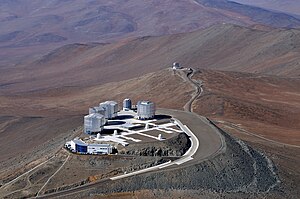Paranal Observatory
 | |||||||||||
| Alternative names | ESO's Paranal Observatory | ||||||||||
|---|---|---|---|---|---|---|---|---|---|---|---|
| Organization | European Southern Observatory | ||||||||||
| Observatory code | 309 | ||||||||||
| Location | Cerro Paranal, Chile | ||||||||||
| Coordinates | 24°37′38″S 70°24′15″W / 24.62722°S 70.40417°W | ||||||||||
| Altitude | 2,635 metres (8,645 ft) | ||||||||||
| Established | 1 April 1999 | ||||||||||
| Website | eso.org/public/teles-instr/paranal-observatory/ | ||||||||||
| Telescopes | |||||||||||
| |||||||||||
| | |||||||||||
Paranal Observatory is an
The
Two major new facilities are under construction nearby: the southern part of the
Telescopes
Aerial view
From an aerial view of the Paranal Observatory, the four large units of the VLT with their four small, dome-shaped auxiliary telescopes can be clearly seen. The Survey Telescope, VST, is immediately adjacent to the VLT and seen in between two of its units, while VISTA is located on a secondary peak, some 1,500 m away in the background (see image).
Very Large Telescope
The
VISTA Survey Telescope
VISTA is the Visible & Infrared Survey Telescope for Astronomy, a 4.0-metre telescope with a wide field of view, focusing on infrared surveys of the sky. It was built close to ESO's VLT by a consortium of 18 universities from the United Kingdom, led by Queen Mary University of London. VISTA was handed over to the European Southern Observatory in December 2009.
VLT Survey Telescope (VST)
The VLT Survey Telescope or VST is a 2.6-metre telescope with a wide field imager intended to aid the four Very Large Telescope (VLTs) in their scientific aims.
Next-Generation Transit Survey (NGTS)
The
SPECULOOS Southern Observatory (SSO)
The SPECULOOS Southern Observatory (SSO) consists out of four telescopes, called Europa, Io, Callisto, and Ganymede. ESO hosts the 1-meter telescopes and the project is led by the University of Liège. The project aims to find exoplanets around ultracool dwarf stars and brown dwarfs. The project builds on the success of the TRAPPIST telescope. The telescopes are located next to the NGTS.[4]
Other buildings
As well as the telescopes, control buildings and maintenance facilities, Paranal has a
Gallery
This section contains an unencyclopedic or excessive gallery of images. |
-
Main entrance of the Paranal Observatory.
-
A 360-degree panorama of the southern sky above the Paranal platform
-
TheESO Residencia(center left) and basecamp at Paranal
-
Aerial view
-
Paranal platform with the VLTs, the ATs and VST
-
The platform as night sets
-
Beam of the laser guide star facility at VLT's Yepun Unit
-
Time-lapse taken at Paranal, showing the Magellanic Clouds
-
Full tour of the facility inLEGO® form
-
This collection of video clips shows daily life at the observatory
-
Tour the Skies.[6]
-
Colour in the air.[7]
-
Three of the SPECULOOS telescopes
Popular culture and other uses
To illustrate the isolation of the Paranal Observatory from the lights of civilization, it is located 38 kilometres (24 mi) in straight-line distance north of Paposo, population 259, the nearest community to the observatory.[8]
The VLT hotel, the Residencia, served as a backdrop for part of the 2008 James Bond film Quantum of Solace.
The observatory's facilities were used to stage the Pacific Alliance's fourth summit in June 2012, formally launching the organization.
On 14 March 2013,
See also
- Very Large Telescope
- List of largest optical reflecting telescopes
- List of astronomical observatories
- List of highest astronomical observatories
- Other observatories in Chile:
- European Northern Observatory
- VVV Survey
References
- ^ "Very Large Telescope: Requirements for Scientific Instruments on the VLT Unit Telescopes" (PDF). www.eso.org. Retrieved 4 January 2024.
- ^ "New Exoplanet-hunting Telescopes on Paranal". European Southern Observatory. Retrieved 22 May 2015.
- ^ "About NGTS". Next Generation Transit Survey. Archived from the original on 31 May 2015. Retrieved 3 September 2015.
- ^ "Paranal map and safety". eso.org. Retrieved 2020-03-10.
- ^ "Proyectos—Hoteles". Paula Gutiérrez Erlandsen. Retrieved 3 September 2015.
- ^ "Tour the Skies". eso.org. Retrieved 27 January 2020.
- ^ "Colour in the air". eso.org. Retrieved 11 February 2020.
- ^ Google Earth











![Tour the Skies.[6]](http://upload.wikimedia.org/wikipedia/commons/thumb/8/8a/Tour_the_Skies_-_potw2004a.jpg/480px-Tour_the_Skies_-_potw2004a.jpg)
![Colour in the air.[7]](http://upload.wikimedia.org/wikipedia/commons/thumb/7/76/Colour_in_the_air_-_Potw2007a.jpg/400px-Colour_in_the_air_-_Potw2007a.jpg)

